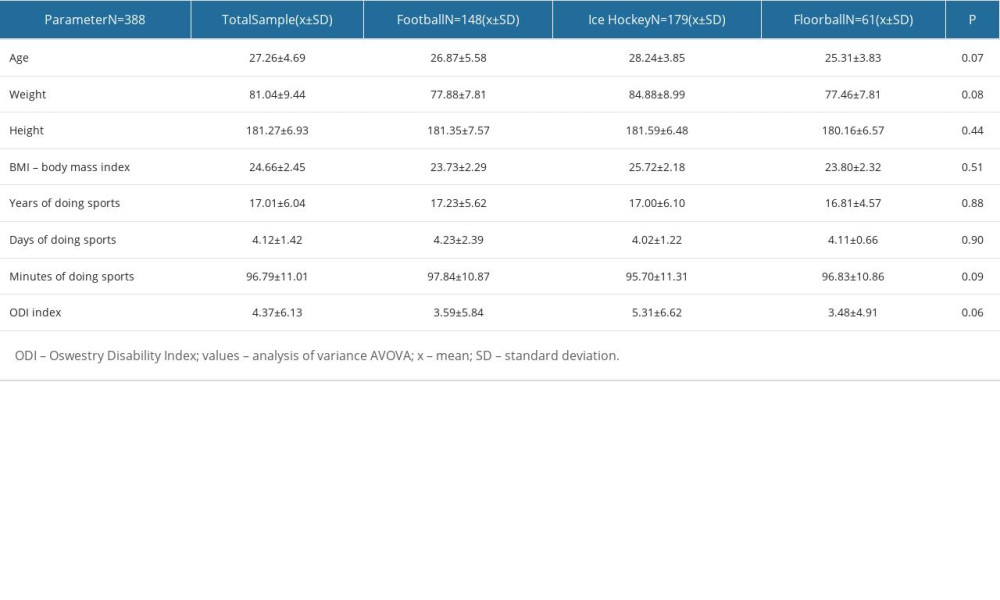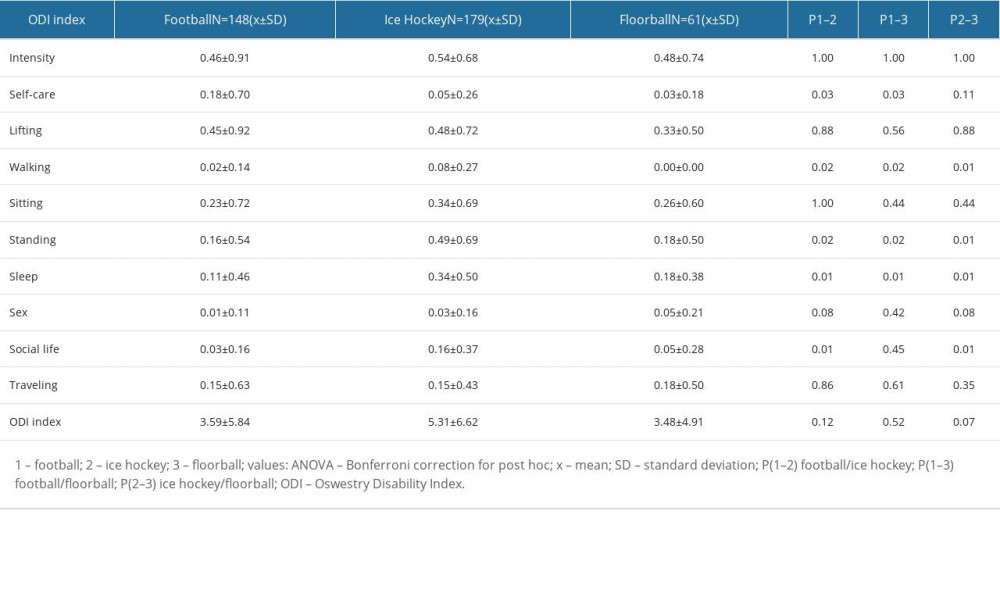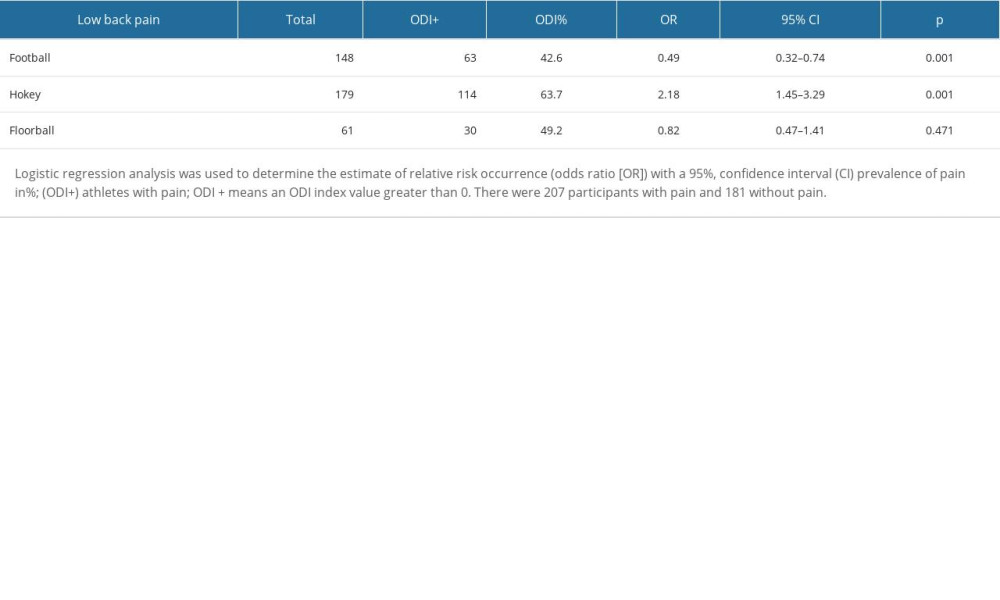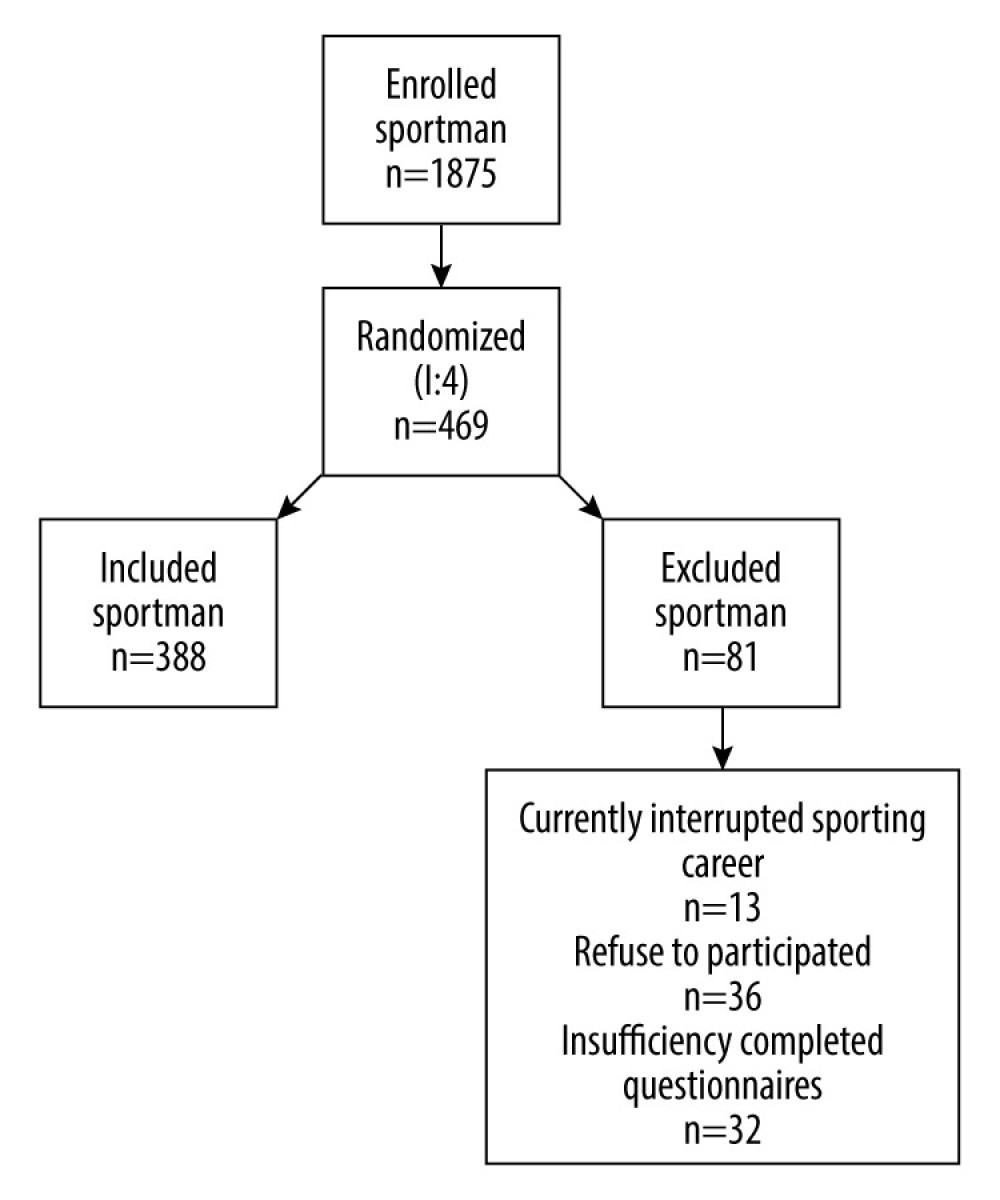06 September 2023: Clinical Research
Comparative Risk Analysis of Low Back Pain among Professional Football, Ice Hockey, and Floorball Athletes
Magdaléna HagovskáDOI: 10.12659/MSM.941386
Med Sci Monit 2023; 29:e941386
Abstract
BACKGROUND: Low back pain (LBP) is a common concern among professional athletes, potentially hindering performance and career longevity. However, comparative assessments of LBP prevalence and severity across various sports remain scarce. This study aimed to evaluate the factors associated with LBP in 388 professional athletes, including football, ice hockey, and floorball players.
MATERIAL AND METHODS: Conducted from June 2021 to September 2022, this cross-sectional study incorporated 388 athletes from national elite clubs, including football (n=148), ice hockey (n=179), and floorball (n=61). The Oswestry Disability Index (ODI), comprising sections like pain intensity, self-care, lifting, walking, sitting, standing, sleeping, sexual life, social life, and traveling, was employed to evaluate spinal pain and disability.
RESULTS: The study found no significant disparities in the LBP assessment among the groups. The relative risk (OR) of LBP and disability varied among the sports: football players displayed a lower risk (OR=0.49; 95% CI 0.32-0.74, P≤0.001), while ice hockey players had a higher risk (OR=2.18; 95% CI 1.45-3.29, P≤0.001) compared to the others. In contrast, the risk for floorball players (OR=0.82; 95% CI 0.47-1.41) did not significantly deviate from that of the other two sports.
CONCLUSIONS: LBP prevalence stood at 42.6% for football players, 60.1% for ice hockey players, and 49.2% for floorball players. Among these, ice hockey players exhibited a 2.18-fold increased risk of developing LBP and associated disability when compared to their football and floorball counterparts.
Keywords: Prevalence, acute pain, Spine, Humans, Football, Hockey, Low Back Pain, Cross-Sectional Studies, athletes, Risk Assessment
Background
Lower back pain (LBP) is of musculoskeletal origin in the area defined by the lowest rib within the upper border and the gluteal groove within the lower border, with the possibility of radiating pain to the thigh (without extending to the knee joint) [1]. Furthermore, the prevalence and risk factors of LBP in athletes are not sufficiently researched [2].
Some studies have shown that up to 18% to 23% of the world’s adults have LBP. Women have a higher prevalence of LBP than men, at rates of 19.8% and 15.9%, respectively. However, when stratified by sex and age, men show a higher prevalence (13.8%) among young adults aged 18 to 27 years than do women (12.5%) [3].
Our systematic review of the prevalence of LBP in athletes generated 4379 records. LBP in athletes was shown to have a point prevalence ranging from 10% to 67%, a 1-year prevalence ranging from 17% to 94%, and a lifetime prevalence ranging from 33% to 84%. The highest prevalence of LBP was found among skiers, floorball players, and rowers, while the lowest was found in shooters, golfers, and triathletes. As in the general population, LBP is quite prevalent among athletes [4].
The prevalence of lumbar pain in young athletes ranges from 5% to 66%. Compared with that of the general population, the pain is largely the same. In a recent study, back pain was reported in 12% of children and adolescents who participate in sports. The pain was greater in girls than in boys [5].
Pain in various segments of the spine is a common problem in athletes. Some sports pose a greater risk of pain than others. Measurement tools for pain assessment also differ. Lumbar spine pain occurs in 67% of gymnasts, 53% of football players, 89% of hockey players and divers, and 50% of tennis players. More specifically, it relates to a large load on the spinal segments and intervertebral discs. The prevalence of cervical spine pain in athletes is 21%, and it is most often seen in connection with disc herniation [2].
The 3 most common causes of back pain are mechanical, degenerative, and inflammatory. Mechanical pain is commonly due to injury to the spine, intervertebral discs, or soft tissues. Disc herniation is a common cause of mechanical back pain. Degenerative pain is caused by osteoarthritis of the spine, including facet joint osteoarthritis, sacroiliac joint osteoarthritis, spinal stenosis, and degenerative disc disease. Inflammatory pain is caused by inflammatory spondyloarthropathies. Sacroiliitis is also commonly seen.
Diagnosis of spinal pain consists of patient history and physical examination. The presence of red flags requires further investigation. Indeed, magnetic resonance imaging (MRI) can be necessary to evaluate soft tissue lesions, nerve root/cord compression from a bulging disc, malignancy, and inflammatory conditions of the spine and surrounding tissues.
The management of LBP is based on etiology, age, and chronicity of pain. For radicular LBP, nonpharmacologic interventions consist of specific exercise, traction, and mobilization of the spine. Nevertheless, there is relatively weak evidence to support such treatments. For non-radicular chronic LBP, there is moderate evidence to support physical therapy, the McKenzie method, and acupuncture [6].
Lumbar spine pain often occurs with sharp, jerky spinal movements or when the person jumps, from rotation in extension to rotation in flexion. Concerning athletes, Wilkerson [7] found that the cause of back pain is reduced activation of deep muscles. Jonasson et al [8] monitored the occurrence of joint and spine pain in 90 elite athletes (the sports monitored included wrestling, gymnastics, ice hockey, and fitness) and in a control group of 20 nonathletes. No significant differences were found in the prevalence of pain in the cervical part of the spine and large joints in the group of athletes and nonathletes. Similarly, Tunås [9] monitored the prevalence of lumbar spine pain in 277 professional football (soccer) players, 190 handball players, and 167 nonathletes. He discovered no significant differences in the prevalence of pain between professional athletes and nonathletes. Todd [10] investigated the prevalence of back and hip pain in young elite skiers, using the Oswestry Disability Index (ODI) and EuroQoL to evaluate general health, activity level, and back and hip pain prevalence. Young elite skiers were also shown not to have increased lifetime prevalence of back pain compared with a non-athletic control group.
However, the methodological weaknesses of these studies does not allow a detailed comparison between different sports or with the general population. The issue of monitoring back pain in athletes thus requires further research [11]. Therefore, our study differs from its predecessors in that it monitors pain and disability in the most frequently performed types of collective sports with the simple and complex ODI. Football, hockey, and floorball are collective and similar at first glance, but they all differ due to several risk factors. Risk factors include flexed body posture, swinging rotational movement with hockey sticks, the hardness of the terrain, and cold weather. Currently, the literature is lacking in its comparisons of frequent types of collective sports regarding the occurrence of pain and disability in the lumbar region of the spine.
Consequently, in this study, we aimed to evaluate the prevalence, severity, and risk factors associated with LBP in 388 professional athletes, including football, ice hockey, and floorball players.
Material and Methods
SAMPLE SIZE:
Currently, the literature has shown that back pain in athletes reaches a prevalence of 30% to 80% [8,9]. The average prevalence of such problems is 50%. We therefore performed a power analysis according to Daniel [12], while the sample size was determined according to the average prevalence of 50%. The minimum sample size was calculated using the following equation: n=Z2 P(1-P)/d2 Z=1.96 for the 95% confidence level; P=0.5 for the expected sample of 50%, and d=0.05 for a 5% margin of error. According to this calculation, a minimum of 384 athletes in team sports was needed. We expected a 20% loss, so we included 469 potential participants.
DATA COLLECTION:
Among collective sports, all clubs at the national level were approached. We focused on athletes playing in the 2 highest leagues. We also chose the 3 most popular sports in the extra league and the first league: football, floorball, and ice hockey. The number of registered athletes in football, hockey, and floorball at the required level was 1875. From this calculation, every fourth athlete was randomly selected. Randomization was performed in Microsoft Office Excel 2016 by an independent person who did not otherwise participate in the study; a sample of 469 individuals was thus included. A total of 388 athletes were included in the study, of which, 81 were excluded for refusing to participate in the study. Data collection was anonymous. All participants answered all questions on the questionnaires. Inconsistent and missing answers were fixed at the time of data collection (Figure 1).
OSWESTRY DISABILITY INDEX:
The ODI was used to assess pain and disability of the spine and contains 10 sections: 1: pain intensity, 2: self-care, 3: lifting, 4: walking, 5: sitting, 6: standing, 7: sleep, 8: sexual life, 9: social life, and 10: travel. The degree of disability ranges from a score of 0 to 5, with higher numbers characterizing higher disability [13,15]. During the evaluation, the numbers from all sections were added together. We divided the sum by 50 (the maximum possible value obtained from the sections) and multiplied the result obtained by 100. The result represents the level of difficulty on a scale from 0% to 100%. Rating (maximum possible total sum from sections): 50×100=% ODI=index. Interpretation: 0% to 20%=minimal pain and disability, 21% to 40%=moderate disability, 41% to 60%=severe disability, 61% to 80%=very severe disability, and 80% to 100%=bedridden.
ODI+means an ODI index value greater than 0.
STATISTICAL PROCESSING:
Descriptive and analytical statistics were used, and data are presented as means and standard deviations. Data normality was verified by the Shapiro-Wilk test in SPSS. Additionally, data were normally distributed; P values were obtained through an ANOVA analysis; and Bonferroni correction for post hoc was also used, with a significance level of P<0.05 (ANOVA was used in Tables 1, 2).
Percentages were evaluated to assess the occurrence and prevalence of pain and disability in the observed group. Logistic regression analysis was used to determine the estimate of risk (odds ratio [OR]) with a 95% CI (logistic regression analysis was used in Table 3).
The independent variables were the 3 types of sports – football, hockey, and floorball – that have an impact on spinal pain and disability. The dependent variables were the results of the ODI and individual sections. Calculations were performed in IBM SPSS Statistics for Macintosh (Version 28, IBM Corp., Armonk, NY, USA).
Results
DEMOGRAPHIC CHARACTERISTICS:
In our study, we had young athletes with an average age of 27 years. They were engaged in 3 kinds of sports: football, ice hockey, and floorball. The groups were homogeneous in regard to age, weight, height, and body mass index. There were also no significant differences between the groups in the evaluation of years of practicing sports, days per week, or minutes per day. In all 3 groups, moderate pain and disability of the lumbar region of the spine were found (Table 1). This was nonspecific, localized chronic LBP without radiation or sensory symptoms.
There were no significant differences between the groups in the assessment of back pain in the ODI scores.
COMPARISON OF THE ODI IN INDIVIDUAL SECTIONS:
In the intensity of pain, lifting, traveling, sitting, and sexual life sections, there were no significant differences between the groups.
In the self-care section, significant differences were found, with greater pain in the group of football players. In this section, there were no differences between ice hockey players or football players.
In the walking section, significant differences were found between all groups. Ice hockey players had the greatest pain, while football players had no pain.
In the standing section, significant differences were found between all groups, while the greatest pain was recorded in hockey players. By contrast, football players and floorball players had significantly less pain.
In the sleeping section, significant differences were found between all groups.
In the social life section, significant differences were found; the greatest pain was noted in ice hockey players. Football players and floorball players had significantly less pain (Table 2).
RISK OF BACK PAIN:
Football players had an OR of 0.49, which means a 0.49-times lower risk of developing LBP than ice hockey and floorball players. However, football players still had a prevalence of pain of 42.6%.
Additionally, ice hockey players had an OR of 2.18, giving them a 2.18-times higher risk of developing LBP than football and floorball players. Their prevalence of pain was 63.7%.
Floorball players had an OR of 0.82, which means that they did not have an increased or decreased risk of LBP in comparison with football and ice hockey players. Their prevalence of pain was 49.2% (Table 3).
Discussion
LIMITATIONS OF THE STUDY:
This study had some limitations. A questionnaire method was used to determine spinal pain and disability, no test batteries were used to assess the stabilizing function of the spine, and pain was not determined according to the prevailing directional preference of individual types of movements. The prevalence of LBP was evaluated during the past year, neglecting to evaluate the prevalence in the past month or week. We also did not evaluate pain intensity separately. We decided to use the ODI; however, compared with other tests, such as the Roland Morris Questionnaire, the ODI is comprehensive in its evaluation.
Conclusions
According to the ODI, the prevalence of LBP was 42.6% in football players, 60.1% in ice hockey players, and 49.2% in floorball players. Ice hockey players also had a 2.18-times greater risk of developing LBP and disability compared with football and floorball players.
Therefore, it would be appropriate to implement back pain prevention programs into daily training routines for elite sports categories, where a high incidence of back pain has been found. Doctors, physiotherapists, and coaches should develop new effective and progressive specific preventive programs for athletes. Interventional movement programs against back pain should also be part of elite athletes’ daily training.
Back pain has a negative impact on the performance and careers of athletes, but also on their personal life. Accordingly, it is necessary to pay sufficient attention to this issue.
Tables
Table 1. Demographics: Mean values and statistical comparison of total sample and of football, ice hockey, floorball players. Table 2. Mean values and statistical comparison of ODI index and ODI sections of football, ice hockey, and floorball players.
Table 2. Mean values and statistical comparison of ODI index and ODI sections of football, ice hockey, and floorball players. Table 3. Percentage and estimate of the relative risk occurrence of lower back pain (LBP) of football, ice hockey, and floorball players.
Table 3. Percentage and estimate of the relative risk occurrence of lower back pain (LBP) of football, ice hockey, and floorball players.
References
1. Almeida DC, Kraychete DC, Low back pain – a diagnostic approach: Revista Dor, 2017; 18; 173-77
2. Trompeter K, Fett D, Platen P, Prevalence of back pain in sports: A systematic review of the literature: Sports Med, 2017; 47(6); 1183-207
3. Kahere M, Ginindza T, The prevalence and risk factors of chronic low back pain among adults in KwaZulu-Natal, South Africa: An observational cross-sectional hospital-based study: BMC Musculoskelet Disord, 2021; 22(1); 955
4. Farahbakhsh F, Rostami M, Noormohammadpour P, Prevalence of low back pain among athletes: A systematic review: J Back Musculoskelet Rehabil, 2018; 31(5); 901-16
5. Mueller S, Mueller J, Stoll J, Incidence of back pain in adolescent athletes: A prospective study: BMC Sports Sci Med Rehabil, 2016; 8; 38
6. Casiano VE, Sarwan G, Dydyk AM, Back pain. [Updated 2023 Feb 20]: StatPearls [Internet], 2023, Treasure Island (FL), StatPearls Publishing Available fromhttps://www.ncbi.nlm.nih.gov/books/NBK538173/
7. Wilkerson GB, Giles JL, Seibel DK, Prediction of core and lower extremity strains and sprains in collegiate football players: A preliminary study: J Athl Train, 2012; 47(3); 264-72
8. Jonasson P, Halldin K, Karlsson J, Prevalence of joint-related pain in the extremities and spine in five groups of top athletes: Knee Surg Sports Traumatol Arthrosc, 2011; 19(9); 1540-46
9. Tunås P, Nilstad A, Myklebust G, Low back pain in female elite football and handball players compared with an active control group: Knee Surg Sports Traumatol Arthrosc, 2015; 23(9); 2540-47
10. Todd C, Aminoff AS, Agnvall C, No difference in prevalence of spine and hip pain in young Elite skiers: Knee Surg Sports Traumatol Arthrosc, 2018; 26(7); 1959-65
11. Tuominen M, Stuart MJ, Aubry M, Injuries in men’s international ice hockey: A 7-year study of the International Ice Hockey Federation Adult World Championship Tournaments and Olympic Winter Games: Br J Sports Med, 2015; 49(1); 30-36
12. Daniel WW, Biostatistics: A Foundation for Analysis in the Health Sciences: WileyCom, 2018, Wiley
13. Fairbank JC, Pynsent PB, The Oswestry Disability Index: Spine (Phila Pa 1976), 2000; 25(22); 2940-52
14. Bahr R, Andersen SO, Løken S, Low back pain among endurance athletes with and without specific back loading – a cross-sectional survey of cross-country skiers, rowers, orienteerers, and nonathletic controls: Spine (Phila Pa 1976), 2004; 29(4); 449-54
15. Mičánková Adamová B, Hnojčíková M, Vohaňka S, The Oswestry Questionnaire, Version 2.1a-Results in patients with lumbar spinal stenosis, comparison with the previous version of the questionnaire: Cesk Slov Neurol N, 2012; 75/108(4); 460-67
16. Líška D, Kremencký J, The level of dorsiflexion in young gymnasts: Sci Gymnast J, 2022; 14(2); 201-10
17. Liptáková E, Barcalová M, Živčák J, The impact of spiral stabilisation exercise on individuals’ postural system: International Scientific Journal Of Kinesiology, 2020; 13(1); 16-27
18. Kobesova A, Andel R, Cizkova K, Can exercise targeting mid-thoracic spine segmental movement reduce back pain and improve sensory perception in cross-country skiers?: Clin J Sport Med, 2021; 31(2); e86-e94
19. Fett D, Trompeter K, Platen P, Back pain in elite sports: A cross-sectional study on 1114 athletes: PLoS One, 2017; 12(6); e0180130
20. Moradi V, Memari AH, ShayestehFar M, Kordi R, Low back pain in athletes is associated with general and sport specific risk factors: A comprehensive review of longitudinal studies: Rehabil Res Pract, 2015; 2015; 850184
21. Müller J, Müller S, Stoll J, Back pain prevalence in adolescent athletes: Scand J Med Sci Sports, 2017; 27(4); 448-54
22. Legault ÉP, Descarreaux M, Cantin V, Musculoskeletal symptoms in an adolescent athlete population: A comparative study: BMC Musculoskelet Disord, 2015; 16; 210
23. Schulz SS, Lenz K, Büttner-Janz K, Severe back pain in elite athletes: A cross-sectional study on 929 top athletes of Germany: Eur Spine J, 2016; 25(4); 1204-10 Erratum in: Eur Spine J. 2016;25(3): 973
24. Wade M, Campbell A, Smith A, Investigation of spinal posture signatures and ground reaction forces during landing in elite female gymnasts: J Appl Biomech, 2012; 28(6); 677-86
Tables
 Table 1. Demographics: Mean values and statistical comparison of total sample and of football, ice hockey, floorball players.
Table 1. Demographics: Mean values and statistical comparison of total sample and of football, ice hockey, floorball players. Table 2. Mean values and statistical comparison of ODI index and ODI sections of football, ice hockey, and floorball players.
Table 2. Mean values and statistical comparison of ODI index and ODI sections of football, ice hockey, and floorball players. Table 3. Percentage and estimate of the relative risk occurrence of lower back pain (LBP) of football, ice hockey, and floorball players.
Table 3. Percentage and estimate of the relative risk occurrence of lower back pain (LBP) of football, ice hockey, and floorball players. Table 1. Demographics: Mean values and statistical comparison of total sample and of football, ice hockey, floorball players.
Table 1. Demographics: Mean values and statistical comparison of total sample and of football, ice hockey, floorball players. Table 2. Mean values and statistical comparison of ODI index and ODI sections of football, ice hockey, and floorball players.
Table 2. Mean values and statistical comparison of ODI index and ODI sections of football, ice hockey, and floorball players. Table 3. Percentage and estimate of the relative risk occurrence of lower back pain (LBP) of football, ice hockey, and floorball players.
Table 3. Percentage and estimate of the relative risk occurrence of lower back pain (LBP) of football, ice hockey, and floorball players. In Press
12 Mar 2024 : Clinical Research
Metabolomic Alterations in Methotrexate Treatment of Moderate-to-Severe PsoriasisMed Sci Monit In Press; DOI: 10.12659/MSM.943360
14 Mar 2024 : Clinical Research
Renal Dysfunction Increases Risk of Adverse Cardiovascular Events in 5-Year Follow-Up Study of Intermediate...Med Sci Monit In Press; DOI: 10.12659/MSM.943956
15 Mar 2024 : Clinical Research
Impact of One-Lung Ventilation on Oxygenation and Ventilation Time in Thoracoscopic Heart Surgery: A Compar...Med Sci Monit In Press; DOI: 10.12659/MSM.943089
14 Mar 2024 : Clinical Research
Differential DHA and EPA Levels in Women with Preterm and Term Births: A Tertiary Hospital Study in IndonesiaMed Sci Monit In Press; DOI: 10.12659/MSM.943895
Most Viewed Current Articles
17 Jan 2024 : Review article
Vaccination Guidelines for Pregnant Women: Addressing COVID-19 and the Omicron VariantDOI :10.12659/MSM.942799
Med Sci Monit 2024; 30:e942799
14 Dec 2022 : Clinical Research
Prevalence and Variability of Allergen-Specific Immunoglobulin E in Patients with Elevated Tryptase LevelsDOI :10.12659/MSM.937990
Med Sci Monit 2022; 28:e937990
16 May 2023 : Clinical Research
Electrophysiological Testing for an Auditory Processing Disorder and Reading Performance in 54 School Stude...DOI :10.12659/MSM.940387
Med Sci Monit 2023; 29:e940387
01 Jan 2022 : Editorial
Editorial: Current Status of Oral Antiviral Drug Treatments for SARS-CoV-2 Infection in Non-Hospitalized Pa...DOI :10.12659/MSM.935952
Med Sci Monit 2022; 28:e935952









